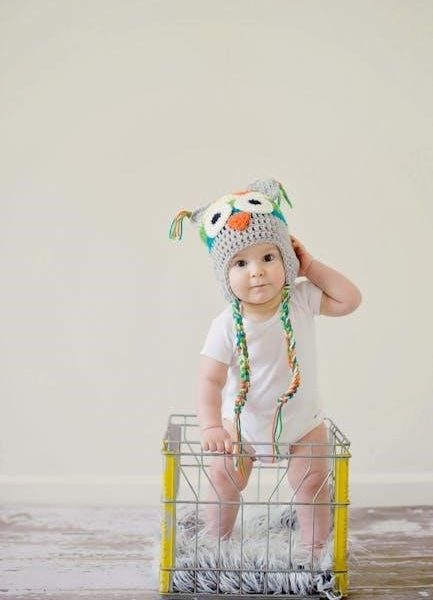
yarn guide
Choosing the right yarn is essential for knitting‚ crochet‚ and textile projects. With various natural‚ synthetic‚ and blended options‚ understanding yarn types and their characteristics ensures the best results for your creative endeavors.
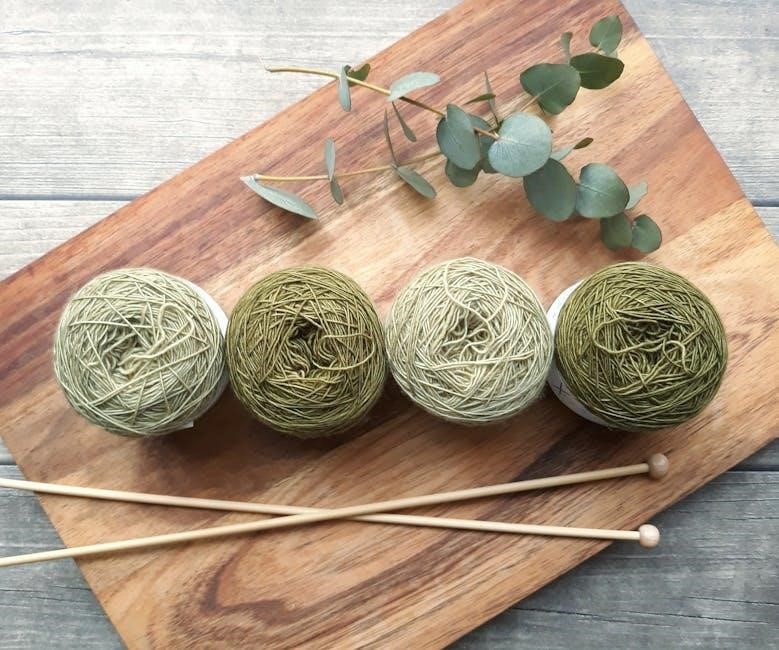
Types of Yarn
Yarns are categorized into natural‚ synthetic‚ and blended fibers‚ each offering unique qualities. Natural yarns provide breathability and softness‚ while synthetic yarns are durable and budget-friendly. Blended yarns combine the best of both worlds for versatility and performance.
2.1 Natural Fibers
Natural fibers are derived from plants or animals‚ offering breathability‚ softness‚ and sustainability. Cotton is ideal for summer wear‚ being lightweight and moisture-wicking. Wool provides warmth and elasticity‚ perfect for winter clothing. Silk‚ luxurious and smooth‚ is great for delicate textiles. Bamboo yarn is eco-friendly and hypoallergenic‚ suitable for sensitive skin. Linen‚ strong and durable‚ is often used for home textiles. These fibers are biodegradable and promote sustainable fashion‚ making them a popular choice for crafting projects that require comfort and a natural feel;
2.2 Synthetic Fibers
Synthetic fibers are man-made materials crafted through chemical processes‚ offering durability‚ affordability‚ and easy care. Acrylic yarn is lightweight‚ machine-washable‚ and ideal for beginners‚ while polyester is strong and wrinkle-resistant‚ perfect for home décor. Nylon is exceptionally durable‚ making it great for outdoor projects. Spandex adds stretch‚ ideal for sportswear. These fibers are cost-effective and come in a wide range of colors and textures‚ making them versatile for various projects. They are low maintenance and suitable for everyday use‚ though some may lack breathability compared to natural fibers.
2.3 Blended Fibers
Blended fibers combine natural and synthetic materials to offer a balance of comfort‚ durability‚ and easy care. These yarns merge the softness and breathability of natural fibers with the strength and low-maintenance properties of synthetics. For example‚ wool-polyester blends provide warmth and machine-washable convenience‚ while cotton-polyester mixes offer durability and wrinkle resistance. Blended yarns are versatile‚ making them ideal for a wide range of projects‚ from everyday clothing to home textiles. They often cater to budget-friendly needs while maintaining quality‚ ensuring a practical and sustainable choice for crafters seeking the best of both worlds.

Yarn Characteristics
Yarn characteristics‚ such as weight‚ texture‚ and elasticity‚ influence the feel‚ drape‚ and appearance of finished projects‚ ensuring the right material for desired outcomes in knitting or crochet.
3.1 Weight
Yarn weight refers to its thickness and is categorized from lace (finest) to bulky (thickest). Weight determines the project’s texture‚ drape‚ and required tools. Lace weight is ideal for delicate patterns‚ while bulky yarn creates quick‚ thick fabrics. Common categories include super fine‚ fine‚ light‚ medium‚ and chunky. Each weight suits specific projects‚ such as socks for fine yarn or blankets for bulky. Choosing the correct weight ensures proper stitch definition and fabric density‚ making it essential for achieving desired results in knitting or crochet. Proper weight selection enhances both functionality and aesthetic appeal of the final product.
3.2 Texture
Yarn texture refers to its surface quality and feel‚ ranging from smooth to chunky. It influences the fabric’s visual appeal and comfort. Smooth yarns create crisp stitches‚ while textured yarns add visual interest. Tweedy‚ bouclé‚ and novelty yarns offer unique effects‚ enhancing creativity. Soft yarns‚ like merino wool‚ are ideal for garments requiring comfort‚ while durable textures‚ such as tweed‚ suit long-lasting projects. The right texture ensures the desired aesthetic and functionality‚ making it a key factor in project success. Proper texture selection enhances both the visual and tactile experience of the finished product.
3.3 Elasticity
Yarn elasticity determines how well it stretches and returns to its original shape‚ crucial for garments requiring flexibility. Natural fibers like wool and alpaca offer excellent elasticity‚ ideal for knits that need shape retention. Synthetic yarns‚ such as acrylic‚ may lack natural stretch but can be blended with elastomeric fibers like spandex for added flexibility. Blended yarns combine the resilience of natural fibers with the durability of synthetics‚ offering balanced elasticity. High elasticity ensures comfort and longevity‚ making it vital for projects like socks or active wear. Choosing the right yarn elasticity ensures your project is both functional and comfortable.
Fiber Content
Fiber content is a crucial factor in determining yarn properties‚ such as softness‚ durability‚ and care requirements. Natural fibers like cotton‚ wool‚ and silk are prized for their breathability and sustainability. Synthetic fibers‚ including acrylic‚ polyester‚ and nylon‚ offer durability and easy-care features. Blended fibers combine natural and synthetic materials to balance softness and resilience. Understanding fiber content helps in selecting yarns that meet specific project needs‚ whether it’s warmth‚ texture‚ or sustainability. Each fiber type brings unique characteristics‚ ensuring the right choice for crafting garments‚ home textiles‚ or accessories.
Yarn Weight Categories
Yarn weight categories range from 0 (lace) to 7 (jumbo)‚ determining thickness and suitability for projects. Lace weight yarns are delicate and ideal for intricate patterns‚ while super fine yarns‚ like fingering‚ suit socks and baby items. Sport weight yarns are versatile for garments and accessories. Worsteds and chunky yarns are popular for quick‚ textured projects. Bulky yarns work well for thick blankets‚ and jumbo yarns are perfect for rugs and home decor. Each category offers unique possibilities‚ ensuring the right thickness for desired results. Always check the label for gauge and needle size recommendations to achieve the best outcome.
Uses of Yarn
Yarn is versatile for knitting‚ crochet‚ and various crafts. It’s ideal for creating garments‚ home decor‚ and accessories‚ offering endless possibilities for creativity and functionality.
6.1 Knitting
Knitting with yarn allows for the creation of a wide range of items‚ from cozy sweaters and scarves to intricate lace shawls. The choice of yarn weight and fiber significantly impacts the final product‚ with finer yarns suited for delicate patterns and thicker yarns ideal for warm‚ sturdy garments. For beginners‚ medium-weight yarns like worsted or DK are recommended due to their ease of use and versatility. Always consider the yarn’s care instructions to ensure the finished project retains its quality and shape over time. Selecting the right yarn ensures your knitting project turns out as envisioned.
6.2 Crochet
Crochet is a versatile craft that utilizes yarn to create a wide range of items‚ from delicate lace shawls to sturdy home decor. Synthetic yarns like acrylic are ideal for beginners due to their affordability and easy care. Natural fibers such as cotton and bamboo are perfect for summer projects‚ offering breathability and softness. Blended yarns combine the best qualities of natural and synthetic fibers‚ providing durability and comfort. Bulky yarns are great for quick projects like blankets‚ while medium-weight yarns are versatile for garments and accessories. Choosing the right yarn ensures your crochet project is both enjoyable and successful.
6.3 Other Crafts
Beyond knitting and crochet‚ yarn is widely used in various other crafts‚ offering endless creativity. It is ideal for embroidery‚ rug-making‚ and creating decorative items like tassels or pom-poms. Yarn can also be used for macrame‚ a popular trend for wall hangings and plant holders. Additionally‚ it is perfect for weaving‚ tapestries‚ and home decor projects‚ such as making unique wall art or functional items like baskets. The versatility of yarn allows crafters to explore diverse techniques‚ blending colors and textures to create personalized and meaningful pieces; Its adaptability makes it a staple in many artistic and functional crafts beyond traditional needlework.
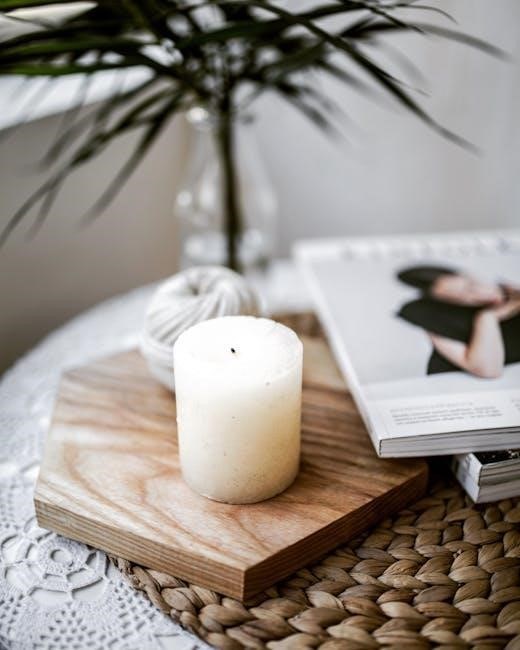
Choosing the Right Yarn
Choosing the right yarn involves considering purpose‚ preferences‚ budget‚ and care requirements to ensure the best material for your project.
7.1 Purpose
Choosing the right yarn begins with understanding the project’s purpose. Yarn selection depends on whether you’re making clothing‚ accessories‚ or home décor. For warmth‚ opt for wool or alpaca. For summer wear‚ breathable fibers like cotton or bamboo are ideal. Durability is key for items like blankets or rugs‚ where bulky or synthetic yarns excel. Texture also plays a role; lace-weight yarns are perfect for delicate patterns‚ while chunky yarns create bold statements. Matching the yarn to the project’s intended use ensures functionality and aesthetic appeal.
7.2 Preferences
Personal preferences significantly influence yarn selection. Softness‚ texture‚ and color are key factors‚ as they affect both the crafting experience and the final product. Some crafters prioritize eco-friendly or sustainable yarns‚ while others focus on budget-friendly options. Texture preferences‚ such as smooth‚ chunky‚ or fuzzy‚ can enhance or detract from a project’s appeal. Additionally‚ yarn weight and drape are crucial for achieving the desired look and feel. Considering these preferences ensures the chosen yarn aligns with both the project’s needs and the crafter’s satisfaction.
7.3 Budget
Budget plays a crucial role in selecting yarn‚ as prices vary significantly based on fiber type‚ quality‚ and brand. Synthetic yarns like acrylic are often more affordable and ideal for budget-friendly projects. Natural fibers‚ such as wool or silk‚ tend to be pricier but offer unique qualities like warmth or luxury. Blended yarns provide a cost-effective balance between natural and synthetic fibers. Setting a budget helps narrow down options‚ ensuring you find a yarn that meets both your financial and project requirements without compromising on essential qualities. Shopping during sales or using substitutes can also help stay within budget.
7.4 Care
Understanding yarn care is vital for maintaining your finished projects. Natural fibers like wool and silk often require hand washing‚ while synthetic yarns such as acrylic and polyester are usually machine-washable. Blended yarns may offer a balance of care options. Always check the yarn label for specific care instructions to ensure longevity. Consider factors like durability‚ wrinkle resistance‚ and moisture-wicking properties when selecting yarn for projects that will undergo frequent use or washing. Proper care ensures your creations remain vibrant‚ soft‚ and intact for years to come‚ making it a key consideration in your yarn choice.
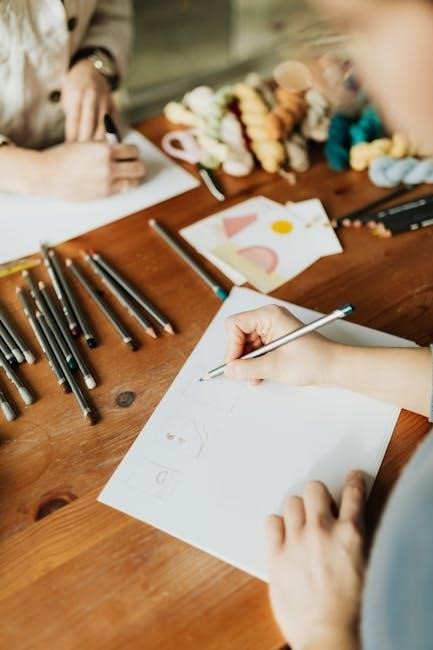
Blended Yarns
Blended yarns combine natural and synthetic fibers‚ offering a mix of softness‚ durability‚ and easy care. For example‚ wool-acrylic blends provide warmth and machine-washable convenience‚ while cotton-polyester mixes offer strength and breathability. These yarns balance the best qualities of their components‚ making them versatile for various projects. They are ideal for garments needing both comfort and longevity‚ such as sweaters or home textiles. Blended yarns often feature improved durability compared to pure natural fibers‚ while retaining softness and texture‚ making them a practical choice for crafters seeking flexibility and performance in their creations.

Eco-Friendly Yarns
Eco-friendly yarns are made from sustainable materials like organic cotton‚ hemp‚ bamboo‚ and recycled fibers‚ reducing environmental impact. These yarns are biodegradable and produced with minimal chemical use‚ promoting eco-conscious crafting. Certifications like GOTS ensure adherence to strict environmental standards. Bamboo yarn‚ for instance‚ is antibacterial and breathable‚ ideal for summer projects. Recycled polyester yarns reuse plastic waste‚ offering a durable and eco-aware choice. While slightly more expensive‚ eco-friendly yarns support sustainable fashion and align with ethical practices‚ making them a responsible option for crafters prioritizing the planet’s well-being.
Yarn Guides and Tools
Yarn guides and tools are essential for managing yarn effectively during crafting or production. These tools ensure proper yarn tension‚ prevent tangling‚ and maintain even yarn flow. Guides come in various types‚ such as traverse guides and roller guides‚ which help control the yarn path during winding or unwinding. Yarn cleaners are also used to keep the fiber path clean‚ preventing debris buildup. Additionally‚ tools like yarn cutters and rewinders simplify handling large skeins or cones. These accessories optimize the yarn winding process‚ ensuring smooth and efficient workflow for crafters and manufacturers alike‚ while maintaining yarn quality and consistency.
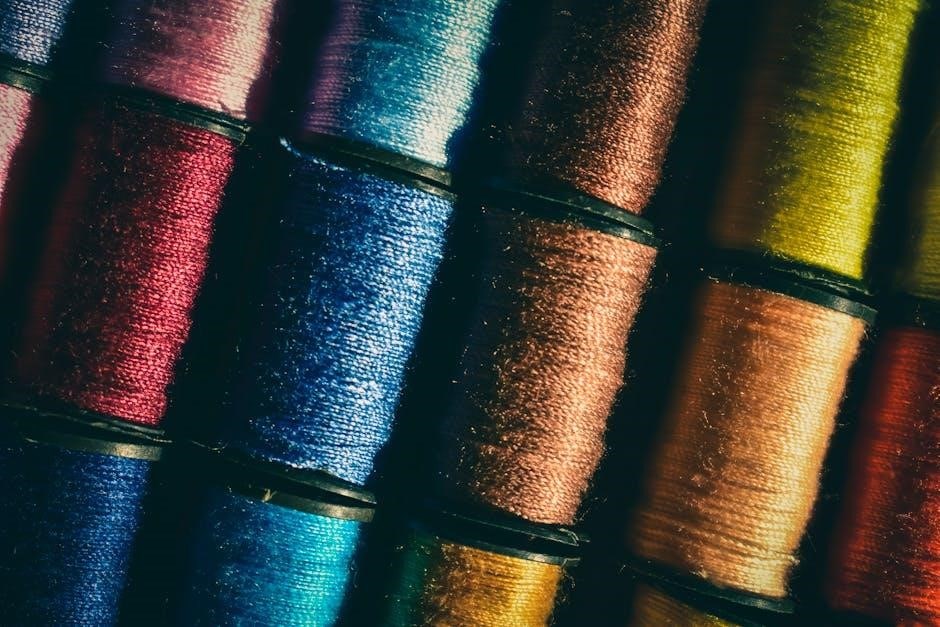
Caring for Yarn
Proper care for yarn ensures its quality and longevity. Always check the yarn label for specific care instructions‚ as different fibers require unique handling. Natural fibers like wool and cotton may need hand washing or gentle cycles‚ while synthetic fibers like acrylic can often be machine washed. Store yarn in a cool‚ dry place away from direct sunlight to prevent fading or moisture damage. Avoid exposing yarn to pests by sealing it in airtight containers. Handle yarn gently to prevent tangling or stretching‚ especially for delicate or blended fibers. Proper care ensures your yarn remains in optimal condition for crafting.
Troubleshooting Common Issues
Common yarn-related issues can arise during projects‚ such as splitting‚ uneven tension‚ or pilling. To address splitting‚ use needles or hooks appropriate for the yarn weight. For uneven tension‚ adjust how tightly you hold the yarn. Pilling can be minimized by choosing yarns with high durability or using fabric shavers. Color bleeding can be prevented by pre-washing yarn before use. If yarn runs out‚ consider substituting with a similar type or purchasing extra. Proper care and handling‚ as outlined in yarn labels‚ can help avoid many of these issues‚ ensuring smooth and successful crafting experiences.
Understanding the different types of yarn and their properties is key to successful knitting‚ crochet‚ and textile projects. By considering fiber content‚ weight‚ and care requirements‚ crafters can make informed decisions that ensure their projects turn out as envisioned. Whether prioritizing softness‚ durability‚ or sustainability‚ the right yarn choice enhances both the process and the final product. With so many options available‚ exploring yarn varieties and their unique qualities opens up endless creative possibilities‚ ensuring every craft is both enjoyable and rewarding.
Related posts:
Archives
- October 2025
- September 2025
- August 2025
- July 2025
- June 2025
- May 2025
- April 2025
- March 2025
- February 2025
- January 2025
- December 2024
- November 2024
- October 2024
- September 2024
- August 2024
- July 2024
- June 2024
- May 2024
- April 2024
- March 2024
- February 2024
- January 2024
- December 2023
- November 2023
- October 2023
- September 2023
- August 2023
- July 2023
- June 2023
- May 2023
Calendar
| M | T | W | T | F | S | S |
|---|---|---|---|---|---|---|
| 1 | 2 | |||||
| 3 | 4 | 5 | 6 | 7 | 8 | 9 |
| 10 | 11 | 12 | 13 | 14 | 15 | 16 |
| 17 | 18 | 19 | 20 | 21 | 22 | 23 |
| 24 | 25 | 26 | 27 | 28 | 29 | 30 |
Leave a Reply
You must be logged in to post a comment.